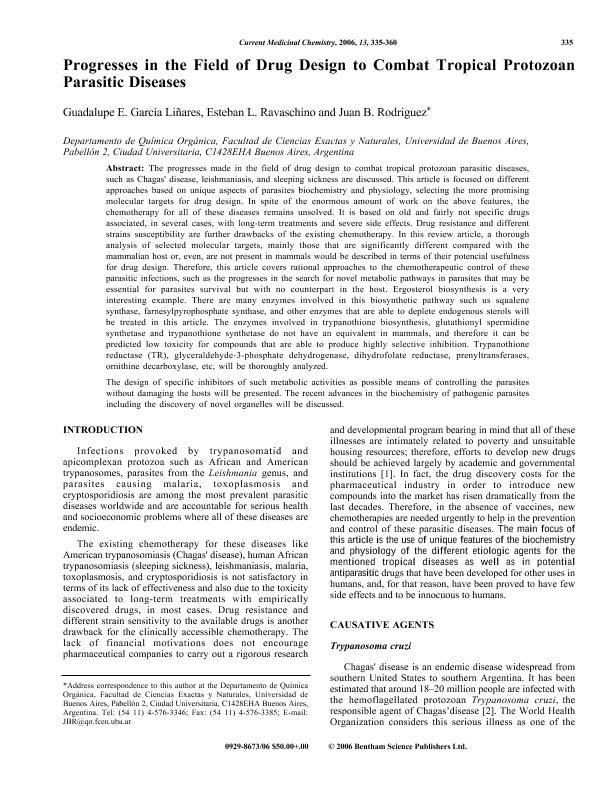Mostrar el registro sencillo del ítem
dc.contributor.author
Garcia Liñares, Guadalupe Eugenia

dc.contributor.author
Ravaschino, Esteban L.
dc.contributor.author
Rodriguez, Juan Bautista

dc.date.available
2019-10-18T19:21:00Z
dc.date.issued
2006-02
dc.identifier.citation
Garcia Liñares, Guadalupe Eugenia; Ravaschino, Esteban L.; Rodriguez, Juan Bautista; Progresses in the field of drug design to combat tropical protozoan parasitic diseases; Bentham Science Publishers; Current Medicinal Chemistry; 13; 3; 2-2006; 335-360
dc.identifier.issn
0929-8673
dc.identifier.uri
http://hdl.handle.net/11336/86464
dc.description.abstract
The progresses made in the field of drug design to combat tropical protozoan parasitic diseases, such as Chagas' disease, leishmaniasis, and sleeping sickness are discussed. This article is focused on different approaches based on unique aspects of parasites biochemistry and physiology, selecting the more promising molecular targets for drug design. In spite of the enormous amount of work on the above features, the chemotherapy for all of these diseases remains unsolved. It is based on old and fairly not specific drugs associated, in several cases, with long-term treatments and severe side effects. Drug resistance and different strains susceptibility are further drawbacks of the existing chemotherapy. In this review article, a thorough analysis of selected molecular targets, mainly those that are significantly different compared with the mammalian host or, even, are not present in mammals would be described in terms of their potencial usefulness for drug design. Therefore, this article covers rational approaches to the chemotherapeutic control of these parasitic infections, such as the progresses in the search for novel metabolic pathways in parasites that may be essential for parasites survival but with no counterpart in the host. Ergosterol biosynthesis is a very interesting example. There are many enzymes involved in this biosynthetic pathway such us squalene synthase, farnesylpyrophosphate synthase, and other enzymes that are able to deplete endogenous sterols will be treated in this article. The enzymes involved in trypanothione biosynthesis, glutathionyl spermidine synthetase and trypanothione synthetase do not have an equivalent in mammals, and therefore it can be predicted low toxicity for compounds that are able to produce highly selective inhibition. Trypanothione reductase (TR), glyceraldehyde-3-phosphate dehydrogenase, dihydrofolate reductase, prenyltransferases, ornithine decarboxylase, etc, will be thoroughly analyzed. The design of specific inhibitors of such metabolic activities as possible means of controlling the parasites without damaging the hosts will be presented. The recent advances in the biochemistry of pathogenic parasites including the discovery of novel organelles will be discussed.
dc.format
application/pdf
dc.language.iso
eng
dc.publisher
Bentham Science Publishers

dc.rights
info:eu-repo/semantics/openAccess
dc.rights.uri
https://creativecommons.org/licenses/by-nc-sa/2.5/ar/
dc.subject
Chagas disease
dc.subject
Trypanosoma cruzi
dc.subject
Chemotherapy
dc.subject
Molecular targets
dc.subject.classification
Química Orgánica

dc.subject.classification
Ciencias Químicas

dc.subject.classification
CIENCIAS NATURALES Y EXACTAS

dc.title
Progresses in the field of drug design to combat tropical protozoan parasitic diseases
dc.type
info:eu-repo/semantics/article
dc.type
info:ar-repo/semantics/artículo
dc.type
info:eu-repo/semantics/publishedVersion
dc.date.updated
2019-09-27T17:10:19Z
dc.journal.volume
13
dc.journal.number
3
dc.journal.pagination
335-360
dc.journal.pais
Estados Unidos

dc.journal.ciudad
Oak Park
dc.description.fil
Fil: Garcia Liñares, Guadalupe Eugenia. Universidad de Buenos Aires. Facultad de Ciencias Exactas y Naturales. Departamento de Química Orgánica; Argentina. Consejo Nacional de Investigaciones Científicas y Técnicas. Oficina de Coordinación Administrativa Ciudad Universitaria. Unidad de Microanálisis y Métodos Físicos en Química Orgánica. Universidad de Buenos Aires. Facultad de Ciencias Exactas y Naturales. Unidad de Microanálisis y Métodos Físicos en Química Orgánica; Argentina
dc.description.fil
Fil: Ravaschino, Esteban L.. Universidad de Buenos Aires. Facultad de Ciencias Exactas y Naturales. Departamento de Química Orgánica; Argentina
dc.description.fil
Fil: Rodriguez, Juan Bautista. Universidad de Buenos Aires. Facultad de Ciencias Exactas y Naturales. Departamento de Química Orgánica; Argentina. Consejo Nacional de Investigaciones Científicas y Técnicas. Oficina de Coordinación Administrativa Ciudad Universitaria. Unidad de Microanálisis y Métodos Físicos en Química Orgánica. Universidad de Buenos Aires. Facultad de Ciencias Exactas y Naturales. Unidad de Microanálisis y Métodos Físicos en Química Orgánica; Argentina
dc.journal.title
Current Medicinal Chemistry

dc.relation.alternativeid
info:eu-repo/semantics/altIdentifier/doi/https://doi.org/10.2174/092986706775476043
dc.relation.alternativeid
info:eu-repo/semantics/altIdentifier/url/http://www.eurekaselect.com/55619/article
Archivos asociados
